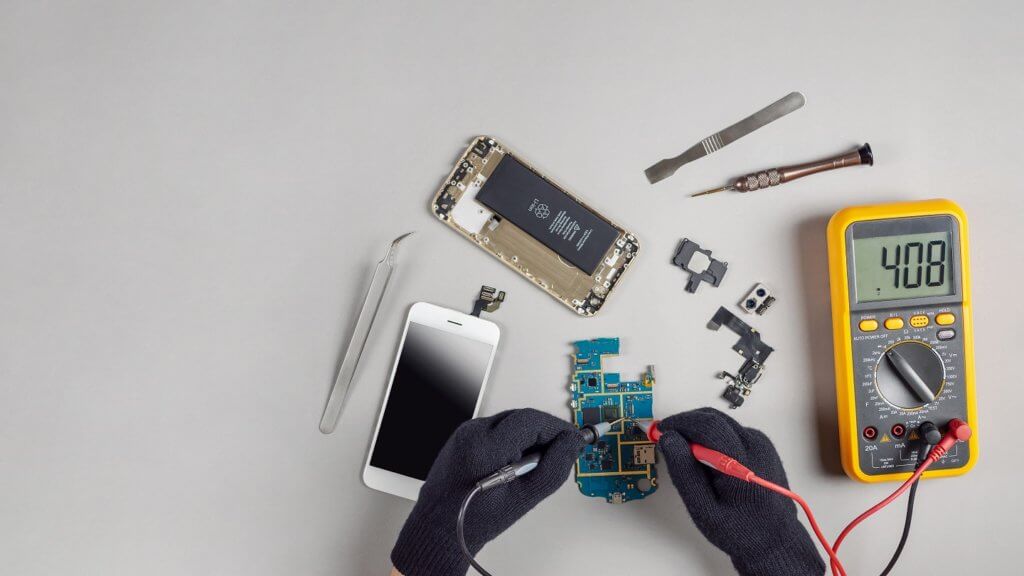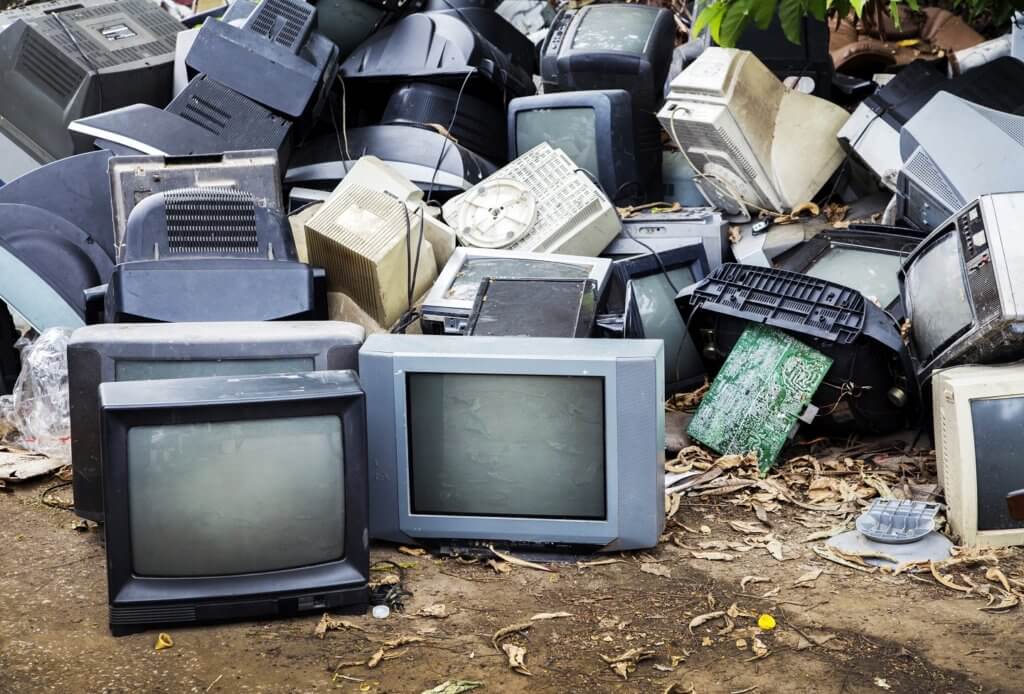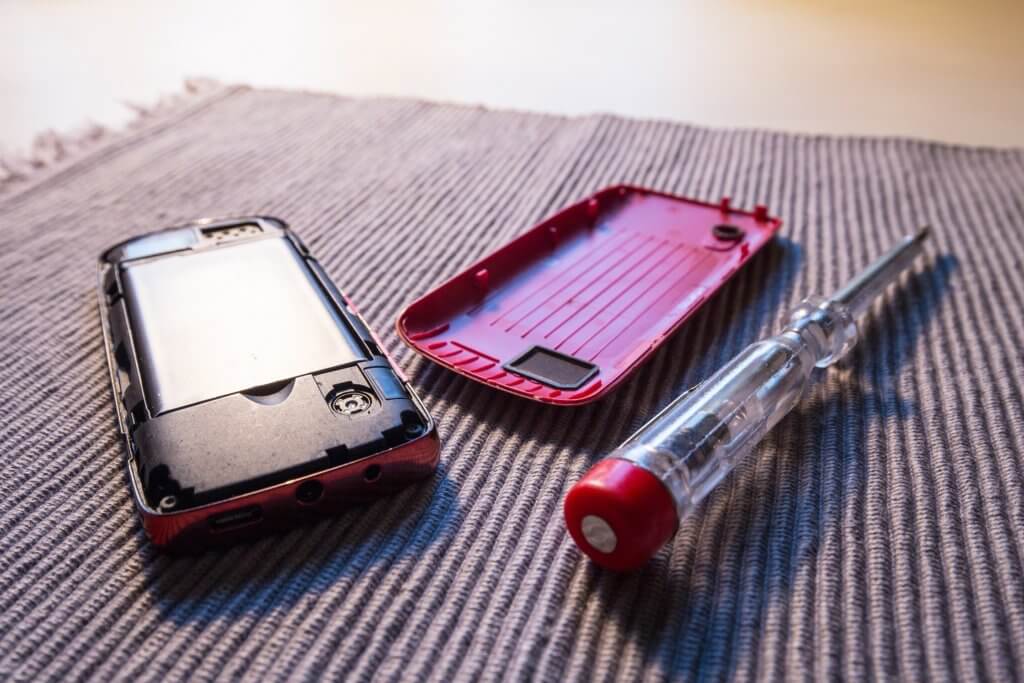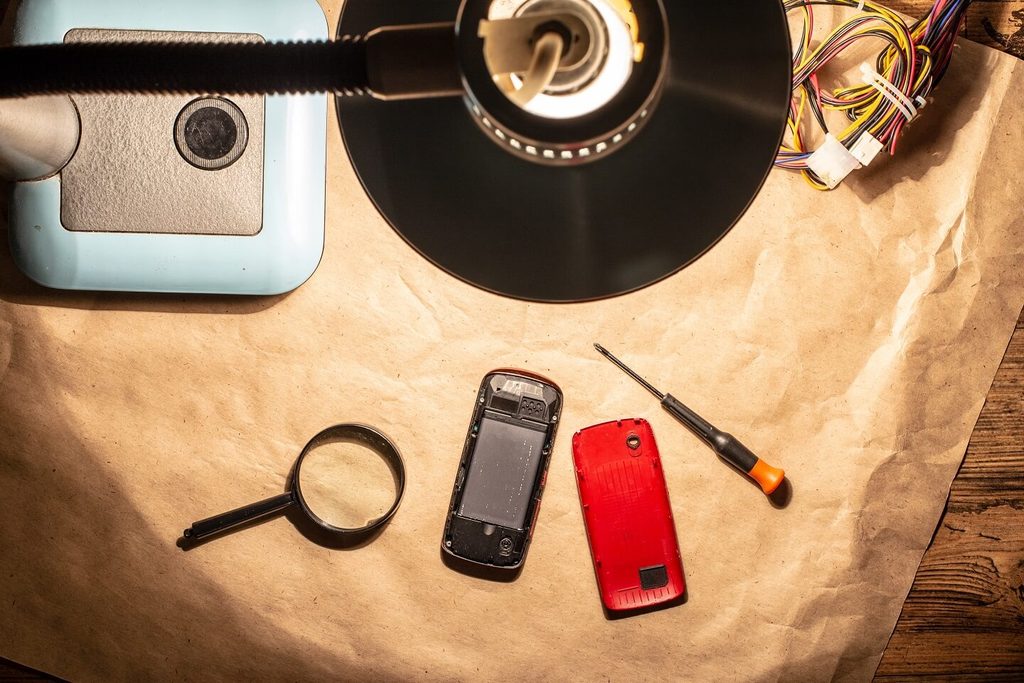The right to repair refers to both an idea as well as proposed legislation that allows a consumer to repair, modify, and improve the devices they have purchased and own rather than being forced into using the manufacturer’s limited approved repair services, parts and accessories.
Repair.org reports that there are, “Over three million Americans that work hard every day to keep our cars, computers, appliances, and other critical infrastructure operating smoothly.” These individuals and their companies provide work, a needed service that save the owners of electronic (and other) devices money, and help prevent needless and dangerous e-waste accumulation.
One thing we have to change is the throwaway culture and waste of phones and other devices. The first step is to build with quality and to make repairing a better option than wasting and replacing. Second is to guarantee the right to the consumer to either repair or give third party support the access to repair or create replacements for faulty parts. Much like the desktop and laptops of today that can last years, so should smartphones and other devices be. Repair and support professionals are essential to help save the consumer money, prevent harmful e-waste, and create a long-standing industry that guarantees jobs.
A History of the Right to Repair
The right to repair is predominantly a US movement that has gained traction in the past decade. In 2012 Massachusetts enacted the Motor Vehicle Owners’ Right to Repair Act. The legislation mandated automobile manufacturers to provide transparency and documentation that would allow anyone to repair their vehicles (source). The major automobile trade organizations agreed in 2018 to abide by the principles outlined in this act in all 50 states. Currently the concept is gaining national attention with Elizabeth Warren including in her platform the right to repair for farming equipment (as a federal law). The right to repair applies to not only vehicles, farming equipment, and household appliances, but also to electronic devices. Which has some of the worst players in the market.
A History of Bad Players
Left to its own whims, the market has a way of corrupting what it can in order for monetary gain.
This idea of pushing consumers to buy new items quickly by artificially reducing the lifespan of products is hardly new. In 1924, Phoebus, a cartel between Osram, Phillips, Tungsram, and General Electric, insured that light bulbs did not exceed an expected life span of 1,000 hours. This cartel was dissolved in 1939, when Eastern European manufacturers started producing low-cost bulbs.
Source
Artificially reducing the lifespan is not new to the market. As demonstrated here, it is documented as early as the 1920s. Doing such should have potential blowback, both revenue- and legalwise. Purposely pushing products with known pollutants into waste management should have consequences. Apple has been caught red-handed throttling processor speeds for certain older devices with operating system updates.
In late 2017, users of Apple, Inc. older iPhone models discovered evidence that recent updates to the phone’s operating system, iOS was purposely throttling the speed of the phone. Apple responded initially that the goal of the software was to prevent overtaxing the older models of lithium-ion batteries to avoid unexpected shutdowns of the phone.
Source
At the time, Apple was ardently opposed to the right to repair and allowing third parties to service their manufactured devices. These, some would say, “unethical” practices would 1. allow Apple to artificially dictate the length of their products lifespan, 2. prevent appropriate repair, and 3. push consumers to replace the artificially deprecated device with a new one.
If there is a history of such acts, recent examples, and current policies and warranties that prohibit an owner from repairing their own device (or contracting a third party), why shouldn’t consumers fight back? Companies are beginning to give way to outside pressure after being caught manipulating their products. Apple, after being sued for their device manipulation and being sued for the right to repair by Australia and Norway, has conceded to allow some independent repair shops to service their devices. But this is after their massive lobbying efforts to kill bills in state legislators that would cement the right to repair on paper.

Are Their Warranties Legal?
In early 2018 the FTC sent six major companies (including Microsoft, Sony, and Nintendo) the notice to make changes to their potentially illegal warranties. Without changes the FTC was threatening to take legal action.
Warranties that limit and require customers to use a product with only authorized parts or accessories and only to repair with authorized parts or services (as well as voiding the warranty if stickers are removed), are believed by the FTC to be conditions in a warranty that are potentially illegal. Using a third party for accessories or repair should not null and void the warranty. Consider using third party ink for a printer, the printer malfunctions (nothing to do with the ink) and then the manufacturer is not obligated to honor the warranty as you’ve used a third party accessory. This not only is restrictive to the consumer’s buying options and would help cement a monopoly, it also helps manufacturers skirt away from responsibility. Consider a broken expensive gaming console, you live in a rural area with no authorized Sony repair services, you take it to a third party repair shop for inspection who discovers the issue is covered by the warranty, you admit to Sony how you found this out and they refuse to honor the warranty because an unauthorized third party inspected your device. Source
Organizations that Support the Right to Repair
The Repair Association was founded in 2013, inspired by the Motor Vehicles Owners’ Right to Repair Act and focuses on this right in the digital and electronic space. Their support and ideologies are demonstrated through the following:
The issue goes beyond cellphone unlocking, because once we buy an object — any object — we should own it. We should be able to lift the hood, unlock it, modify it, repair it … without asking for permission from the manufacturer.
But we really don’t own our stuff anymore (at least not fully); the manufacturers do. Because modifying modern objects requires access to information: code, service manuals, error codes, and diagnostic tools. Modern cars are part horsepower, part high-powered computer. Microwave ovens are a combination of plastic and microcode. Silicon permeates and powers almost everything we own.
This is a property rights issue, and current copyright law gets it backwards, turning regular people — like students, researchers, and small business owners — into criminals. Fortune 500 telecom manufacturer Avaya, for example, is known for suing service companies, accusing them of violating copyright for simply using a password to log in to their phone systems. That’s right: typing in a password is considered “reproducing copyrighted material.
Source
The Repair Association is not alone in their quest to pass legislation and guarantee the consumer the right to repair their own products. Securepairs.org is another org that is made up of security professionals who consider themselves tinkerers, innovators, and fixers. In their mission statement they state,
The right of owners to repair, re-use, fix, modify, and improve the stuff they own is central to our identity as a nation. For three centuries, an implicit right to repair – grounded in Common Law – has been central to the United States’ growth and development as a nation. It was the foundation for American “thrift”: helping farmers, business owners and individuals endure lean times by eeking extra years and decades out of tools, equipment, automobiles, electronics and other possessions.
Source
Many of these companies and professionals that make up these groups are dependent on the right to repair in order to exist as a business. They’re fighting for survival when, in reality, their services should be a non-issue and should be considered normal and essential to extending the life and usage of your electronics.
Another organization that is providing groundbreaking work is iFixit: The Free Repair Manual. The organization in their mission statement states, “Repair saves you money. It saves the environment. And it connects us to our things. Ditch the throwaway economy.”. The org highlights that repair is your right (you bought the device), the right to repair creates jobs and is sustainable. Their website is full of extensive repair guides (use them, they’re VERY useful), a Q&A forum, teardowns of devices (for repair professionals to learn), and a parts and tools store.
Lastly, let’s not forget those that have believed so much in the mission to repair in order to recycle and help the environment, so much so that they have been nonsensically sent to prison.
Dismantling FUD (fear, uncertainty, and doubt)
In Securepairs.org’s Statement of Principles they cover the concept of “FUD” used by lobbyists for appliance and electronic manufacturers. The premise of these campaigns against the right to repair has mainly been fear based. Which usually is telling and typically demonstrates that a side of an argument/issue is hiding its true motives behind the guise of protecting us from an unknown and malicious enemy.
Article 5 of the above referenced Statement of Principles reads,
As technology evolves and reaches deeper into our lives and communities, new and vexing problems and dilemmas are unavoidable. These new and unimagined problems may challenge the assumptions and truths – about security, privacy, and the rights and responsibilities of individuals – that we hold dear.
As security professionals we recognize this inevitability. We also believe that the best way to navigate these as-yet unseen challenges is by proceeding from facts and not FUD (fear, uncertainty and doubt). Too often in our field, fear of the unknown drives conversation about how best to manage technological change. Too often, scaremongering and hypotheticals that serve narrow commercial or political interests are used to derail otherwise fruitful discussion and debate.
As information security professionals, we know that only by focusing on facts and not FUD will we arrive at responses and policies that balance change and innovation with security, privacy, safety and civil liberties. In our advocacy, we will adhere rigorously to the facts and call out fear, uncertainty and doubt whenever and wherever we hear it.
Source
Lobbyists and PR firms for these corporations have had few arguments against the right to repair. If they were transparent about their incentive to capitalize on a revolving door of reduced lifespan consumer goods that are cheaper to replace than repair, maybe we could respect their honesty on their stance and motives…somewhat. Instead they’ve feigned an altruistic stance, pushing the narrative that the right to repair would create an environment that would create cybersecurity risks, which is a fallacy addressed later in this article. When big players must rely on fear mongering, you know this is a losing battle for them.
The Global Cost: Both Economic and Environmental

The bottom line is that corporations against the right to repair and that also purposely reduce their devices’ lifespans are, in fact, only focused on their bottom line: revenue. Revenue is amoral and if a company in this industry is not steered by morals then their actions have a global impact. E-waste is a serious global issue. Electronic devices contain pollutants and cause pollutants while properly disposing of them or recycling. The shift in our manufacturing ethos from quality to quantity has led to a shift in our consumption. And on a finite planet with finite resources, this is not a sustainable model. Syed Faraz Ahmed writes,
But thanks to changes in technology and consumer demand, there is hardly any device now that persists for more than a couple of years in the hands of the original owner. As per the report of ENDS Europe agency, built-in obsolescence increased the proportions of all units sold to replace defective appliances from 3.5 percent in 2004 to 8.3 percent in 2012. The share of large household appliances that had to be replaced within the first five years grew from 7 percent of total replacements in 2004 to 13 percent in 2013. According to a 2014 Gallup poll, 89 percent of young adults (18 to 29) own smartphones; 41 percent of the older generation owned VCRs at the same age.
Source
In 2012 an estimated $206 billion was spent on consumer electronic goods. Of that, only 29% of the generated e-waste was recycled. This is despite US regulations on how e-waste should be recycled. Some of the lack of recycling is due to laziness, some of it is due to ignorance, and some of it is due to the fact that manufacturers see constantly disposed electronic goods as lucrative revenue streams. Source
More concerning than monetary costs are the costs on the environment by wasting electronic products that don’t need to be immediately replaced. E-waste leads to air pollution, water pollution, soil pollution, and information security issues (tossing away devices with personal info on it). Not only are there emissions while producing these products, the disposal of the products cause pollution. Especially when not properly disposed and toxins seep into soil and water. Not to mention those that search for e-waste and burn the devices to obtain and sell the copper in the devices. The list goes on but is not the sole focus of this article.
Without the right to repair we will only see an increase in this e-waste and its dramatic impact on the environment. Codifying the right to repair would be one approach to reducing e-waste. Not only will third parties help elongate the lifetime of an electronic device, manufacturers will be forced to return to quality in order to remain competitive. A quality product that lasts for longer periods of time. A product that isn’t, by design, programmed to fail after an artificially created lifetime for the device
Why Fight for Your Right to Repair?
The following is a synopsis of arguments for the right to repair covered in this article. First and foremost, the most logical argument for the right to repair is that when a consumer buys a device, that device is now their property. The manufacturer cannot dictate the terms of use when it comes to supplementing or repairing the device. The only gray area here should be how your actions impact their warranty. Here is a short list that can easily be augmented:
- “The cure for unsafe products is more repair. The cure for getting rid of faulty parts is more repair, not less,” Gay Gordon-Byrne, Executive Director of The Repair Association
- The right to repair protects third party and consumer rights
- It creates a competitive market as it encourages compatible repairs at cheaper cost
- It is more environmentally friendly, the focus is on a fix instead of disposing of and replacing a device
- It promotes innovation (figuring out repairs, legitimate accessories and parts development, etc.).
- It fosters a 3 million job industry with potential to grow
Security through Obscurity
One argument that manufacturers have used in opposition to the right to repair is that the mandate to provide service manuals, diagnostic software, replacement parts, etc. give hackers the ability to hack the device. They consider it a cybersecurity risk. But NEWSFLASH: hackers DO NOT NEED this info to enact their hacks. That’s the point of hacking, i.e. gaining unauthorized access to overcome a technical problem or, sometimes, commit a crime and exploit an individual or system. Hackers have and will figure out how to hack devices with or without a manual. It’s the third parties and consumers that need these manuals, etc. in order to enable their own security measures, be aware of security loopholes and amend an issue. Joe Grand of Grand Idea Studio states,
We know from hard experience that security through obscurity is a myth…Keeping the workings of electronic devices secret does nothing to reduce the threat from motivated, resourceful hackers or cyber criminals. Instead, it prevents legitimate owners from maintaining and repairing their property as they see fit. Manufacturers who support Right to Repair will actually improve, not weaken, security by providing access to documentation and genuine, high quality replacement components.
Source
As Securepairs.org states, “There is no security through obscurity”. Continued,
There is no security through obscurity. This is axiomatic and a core principle of modern information security, first articulated by the Dutch cryptographer Auguste Kerckhoffs who stated that a “cryptosystem should be secure even if everything about the system, except the key, is public knowledge” (Kerckhoff’s principle).
As information security professionals, we reject all arguments that proceed from the assumption that obscurity equates with- or enhances security. Arguments that seek to conceal the workings of a product in the name of security so as to undermine the rights of owners or their agents to service, repair or modify their property are prima facie false and should be rejected as such. True, verifiable security is the product of secure design and thorough testing and improvement, not secrecy. Systems that rely on secrecy rather than provable security are destined to fail. As the Boston-born lock maker Alfred Charles Hobbs noted: “Rogues are very keen in their profession, and know already much more than we can teach them.”
Source

The Way Forward with Right to Repair
With legislation currently pending in twenty states (the most recent addition being California which has huge implications for its large economy and tech based companies), the right to repair being part of the national discourse during the Presidential election, Apple’s recent decision to grant some third parties the right to repair Apple devices, current lawsuits against Apple for intentionally sabotaging the device’s lifetime, and the general public sentiment…things are looking good for the right to repair. Regardless, there is work to do. As for legislation, you can contact your state reps and legislators to urge them to consider and vote for the right to repair. Visit here for more information.
In the meantime, it’s important to also focus on how to reduce e-waste without the right to repair.
- We can also push for legislation that requires brands to offer buy-back or return systems for old equipment. This would force their hand to intentionally build a quality device, designed to last as long as possible.
- Manufacturers should also be required to help develop e-waste sites in other countries instead of just dumping our waste there. This is too much of a global waste hazard. We cannot throw away and forget our devices…they still exist somewhere and become someone else’s problem.
- Sell your used device to someone or a reseller. But first read how to properly clear your device for security purposes.
- Donate your device to a good cause, friend, or family member, e.g. Cell Phones for Soldiers. Also, read our article on how to donate your smartphones.
Conclusion
The most compelling recent development for the right to repair was in 2017 and is a note in the U.S. Supreme Court’s ruling in Lexmark vs. Impression Products. Noted is, “when a patentee sells an item, that product ‘is no longer within the limits of the [patent] monopoly’ and instead becomes the ‘private, individual property’ of the purchaser.” (Source). That point has been exhaustively expressed in this article. A product is the owners upon purchase. It’s not an innate leasing agreement between the manufacturer and the purchaser. If manufacturers don’t want consumers to take their products to repair services or buy replacement parts, then build products that are meant to last. We are surrounded by enough monopolies…this is just one space that manufacturers will not be allowed to manipulate and dominate. The right to repair is positive for cost savings, innovation, job creation, and reducing e-waste. You have to be focused on only one thing if you’re against it: greed. So, move over greed, we’ll fix this.
